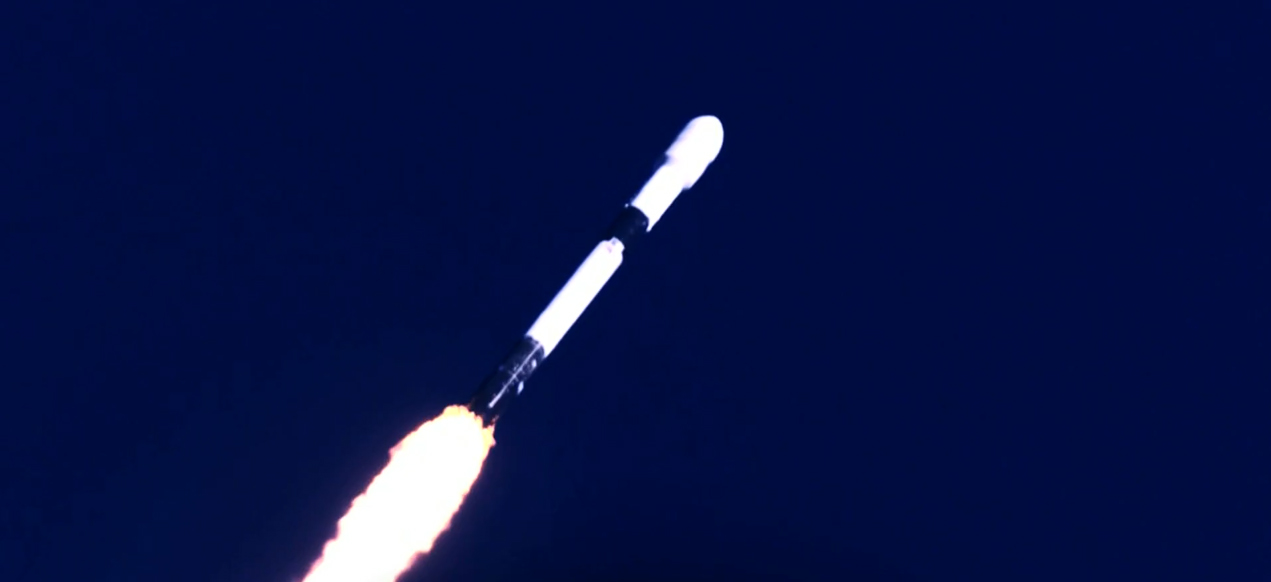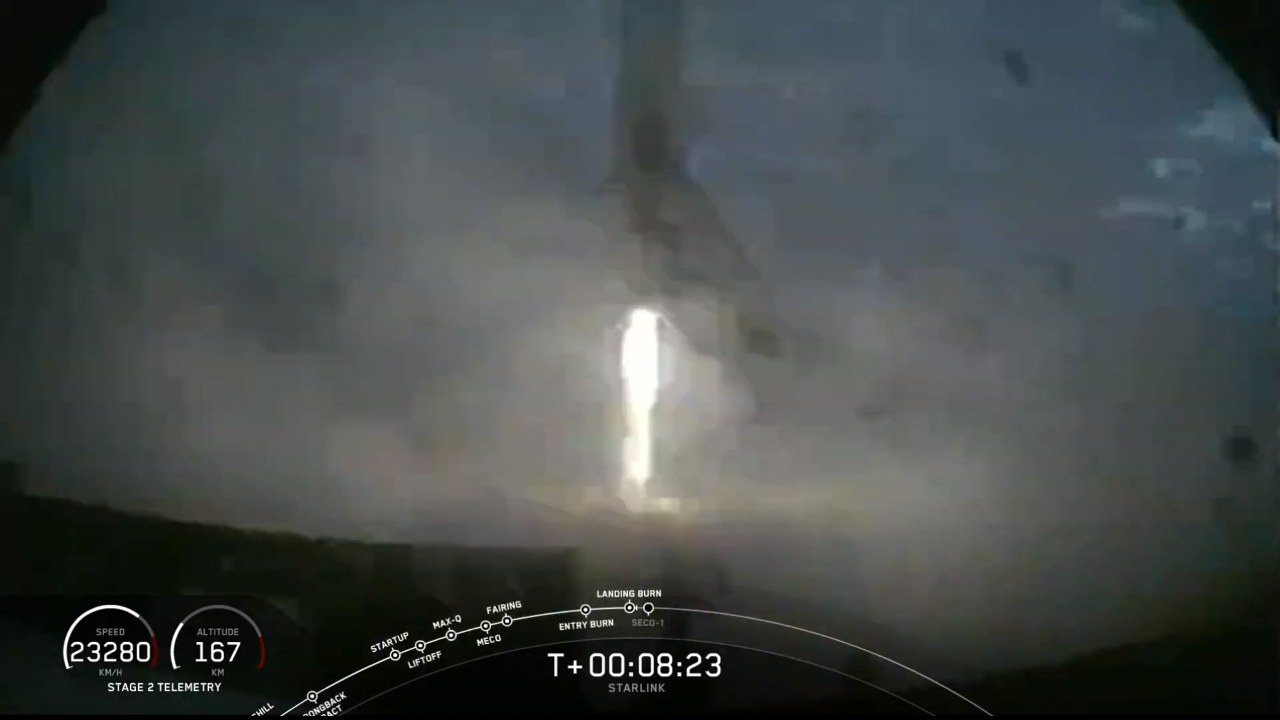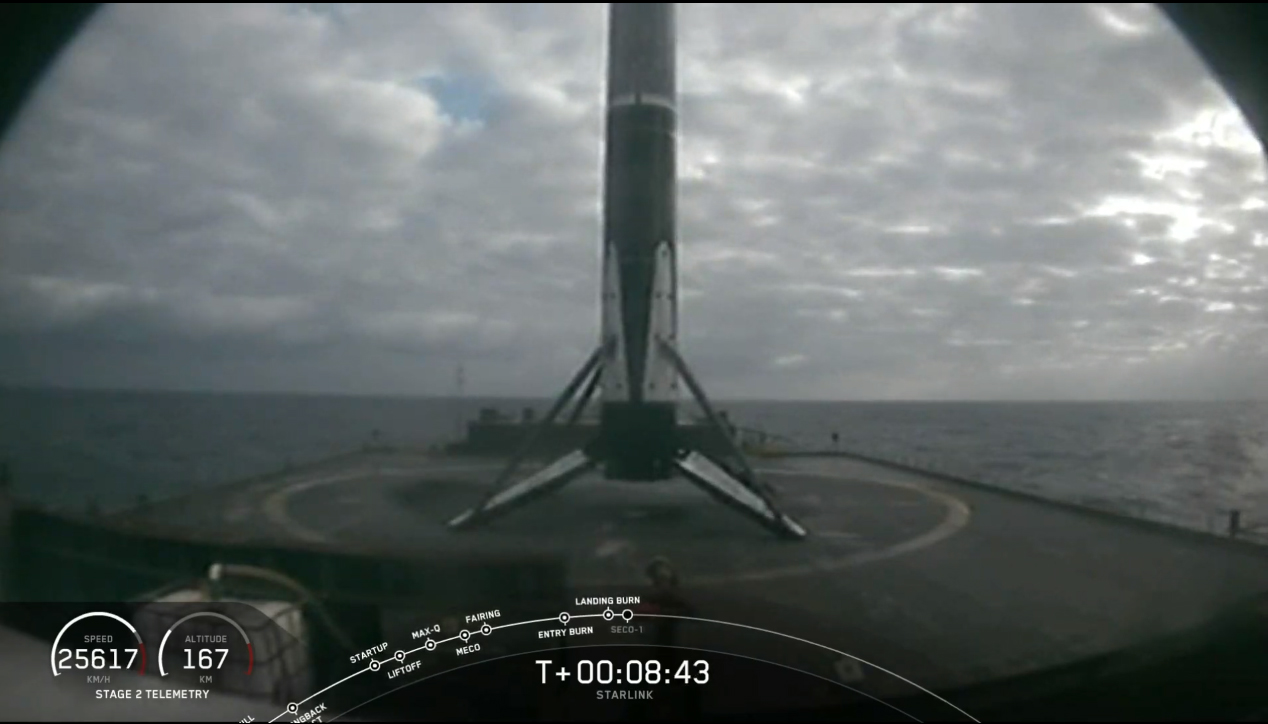SpaceX just launched 60 new Starlink internet satellites and nailed rocket landing at sea
There's more than 800 Starlink satellites in orbit now.
CAPE CANAVERAL, Fla. — SpaceX successfully launched a full stack of Starlink internet satellites into today (Oct. 18) and capped off the mission with a successful rocket landing at sea.
A two-stage Falcon 9 rocket blasted off from NASA's historic Pad 39A here at NASA's Kennedy Space Center at 8:25 a.m. EDT (1225 GMT) carrying 60 new Starlink satellites for SpaceX's growing constellation in orbit.
Approximately 9 minutes later, the booster's first stage returned to Earth, landing on one of SpaceX's drone ships in the Atlantic Ocean in a smooth touchdown. The massive ship, called Of Course I Still Love You, is one of two in the company’s fleet of recovery vessels that catch falling boosters and return them to port.
Related: SpaceX's Starlink satellite megaconstellation launches in photos

It was nothing but blue skies over the Space Coast today. Thanks to crystal clear skies, onlookers could follow the rocket from launch to stage separation.
"A great way to start off a Sunday," SpaceX production supervisor Andy Tran said during live launch commentary.
Known as B1051, the booster featured in today’s flight now has six launches and landings under its belt — the second Falcon 9 to do so. This frequent flier has ferried four different Starlink payloads to space, as well as a trio of Earth-observing satellites for Canada and an uncrewed Dragon spacecraft for NASA’s Demo-1 mission back in 2019. The landing today marked the 62st recovery of a Falcon first stage since SpaceX recovered its first booster in 2015.
Get the Space.com Newsletter
Breaking space news, the latest updates on rocket launches, skywatching events and more!
Reusable rockets

Today's flight marked the 18th launch of 2020 for SpaceX and the 95th Falcon 9 flight to date. SpaceX has had a busy summer and could have its busiest launch year yet. Currently that record belongs to 2018, when the company launched 21 times.
This achievement is facilitated by SpaceX’s fleet of flight-proven boosters. Currently in its rocket reserves, SpaceX has five veteran boosters, and three brand new ones that are reserved for upcoming missions. In 2018, SpaceX debuted a souped up version of its workhorse, the Falcon 9 Block 5. This upgraded iteration received a host of new features which included a more robust thermal protection system, titanium grid fins, a more durable interstage (the hardware that connects the rocket’s two stages), and more powerful engines.
Now packing more than 1.7 million pounds of thrust, the upgraded Falcon 9 has performed reliably for the most part (the rocket has experienced two launchpad aborts in recent months)since launching its first payload in 2018 — a communications satellite for Bangladesh. With that launch, the company bid farewell to the moderately reusable Falcons of the past, ushering in a new era where the same rocket has the capability of flying many times.
Ever since, SpaceX has been working to hone its reusable rocket technology. Its track record with flight-proven rockets even earned the company the right to launch military and national security payloads as well as astronauts on previously flown rockets.
Related: Hitch a ride (and back) on a SpaceX Falcon 9 in this awesome video


A Starlink megaconstellation
SpaceX has grand ambitions to help make humanity a multiplanetary species. In order to help fund its Mars ambitions, the company developed a plan to blanket the Earth with internet coverage beamed down from a tight-knit menagerie of broadband satellites. This megaconstellation would consist of thousands of satellites, flying close to the planet in a region of space called low-Earth orbit.
The internet satellite network would be a way for SpaceX and its CEO, Elon Musk, to generate revenue for Mars exploration and the necessary hardware, like more advanced rockets and other spacecraft. Musk has estimated that the Starlink service could generate as much as $30 billion a year, although no actual pricing has been announced yet.
The burgeoning internet service is currently going through a private beta-testing program where company employees have been putting the broadband service through its paces. According to reports from SpaceX team members current data indicates it can support multiple high-definition streams at the same time.
With this launch, the company will have sent more than 800 of the quarter-ton, flat-panel satellites into space — a milestone Musk has said needed to be reached before SpaceX could begin to roll out its service. There are still regulatory hurdles to overcome and more satellites to launch before the service can be offered globally, but initial testing is promising. As a result, the company plans to open up the beta-testing to the public sometime in the near future.
SpaceX created its Starlink megaconstellation with one goal in mind: to provide more affordable high-speed internet access around the globe, especially for those in rural and remote areas. To that end, the company initially planned for a fleet of 1,440 satellites, but has since obtained approval for thousands more.
The Federal Communications Commission has granted SpaceX permission to launch as many as 12,000 of the flat-panel broadband satellites, but SpaceX may not stop there. The company has indicated it will see approval to launch as many as 30,000 of its internet-beaming satellites to beam down high-speed, low-latency Internet signals.
Related: Why SpaceX's Starlink satellites caught astronomers off guard
SpaceX builds its own Starlink satellites at a company facility in Redmond, Washington. (It also manufactures its own user terminals and ground stations at this location.) Despite still being in beta-testing, SpaceX has granted outside users access to its Starlink network. In August, the company partnered with Washington State to provide emergency responders with reliable internet access.
The state is one of several in the Western U.S. that has been devastated by wildfires this year. In August, emergency responders were given several user terminals to connect to the broadband network so that they could have access to reliable internet service to help a region in trouble.
Washington State's Emergency Management department thanked SpaceX for the access to the Starlink network on Twitter earlier this month. The tweet also included a look at the user terminals, which Musk has described as a "UFO on a stick" and boasted their simplicity, saying anyone could connect one with ease. According to a report from CNBC, officials in Washington confirmed that the user terminals are incredibly easy to use, with setup taking only a few minutes.
Also in August, SpaceX used Starlink to connect the administration building and homes on the Hoh Native American reservation in western Washington to high-speed internet, Tran said.
"The Hoh are a Native American tribe living at the mouth of the Hoh river in western Washington state on the Pacific Coast," Tran said. "This remote location had previously hindered access to high-speed broadband, but after the Starlinks were installed the tribe went from practically no connectivity to high-speed internet overnight."
"What a difference high-speed internet can make!" Hoh tribe officials wrote on Twitter this month." Our children can participate in remote learning, residents can access health care. We felt like we'd been paddling up-river with a spoon on this. SpaceX Starlink made it happen overnight." SpaceX hopes to roll out coverage to the U.S. and Canada by the end of the year, but that depends on how well the beta-testing phase goes.
Astronomical Challenge
Despite early reports that Starlink is performing well, the megaconstellation still remains controversial. That’s because it presents a challenge to those studying the night sky.
Astronomers rely on dark skies to make critical observations of the universe and its population of stars, planets, and galaxies. When Starlink first launched, it caught many astronomers off guard as it obscured their observations.
Starlink satellites typically launch in groups of 60, and as they raise their orbit, they can appear as a bright train of dots marching across the night sky. This train has been spotted by photographers around the world and has even shown up in images captured by massive ground telescopes, making it difficult for scientists to discern if a bright streak across the sky is a star or a Starlink satellite.
To help mitigate this, SpaceX is trying to reduce the apparent brightness of its satellites by outfitting them with a sunshield. This special visor helps reduce sunlight from reflecting off the brightest parts of the satellites, namely the antennas.
Related: Avoiding space debris might require new legal framework
But that’s not the only cause for concern. The massive satellite fleet is also worrisome for other rocket companies.
SpaceX’s Starlink isn’t the only internet constellation in the works, Amazon and OneWeb are also planning their own internet beaming services. Rocket Lab CEO, Peter Beck, says the company is starting to feel the effects of congestion in outer space.
The sheer number of objects in space is quickly skyrocketing as more and more small satellites are launched. In turn, that ever-increasing amount of space traffic is making it difficult to find a clear launch path. That’s because outer space is largely an unregulated territory. The last major piece of global space legislation — the outer space treaty — was written five decades ago and does not address the growing commercial rocket industry.
Researchers have warned for decades that this could one day be a substantial issue. In fact, the International Space Station has had to conduct maneuvers to avoid potential collisions with space debris three times so far in 2020. NASA and other space agencies around the world are working on developing missions where debris and defunct satellites can be trapped or even safely moved to another position.
Dynamic duo
As part of its recovery efforts, SpaceX deployed its twin fairing catcher boats — GO Ms. Tree and GO Ms. Chief. The dynamic duo were expected to recover the payload fairings once they've returned to Earth. Both fairing pieces used on this flight have each flown three times.
Tran reported that both recovery ships managed to catch a fairing half, though the net on Go Ms. Tree gave way. SpaceX hopes to launch the fairing pieces again on a future flight.
Up next for SpaceX is the launch of another batch of Starlink satellites. That launch is scheduled to blast off from Space Launch Complex 40 no earlier than Oct. 21. Teams are still investigating an engine anomaly that occurred on Oct. 2, which prevented the launch of an upgraded GPS satellite from getting off the ground.
That issue also pushed back the launch of NASA’s next astronaut crew. Victor Glover, Mike Hopkins, Shannon Walker and Soichi Noguchi are estimated to blast off to the International Space Station sometime before mid-November, allowing SpaceX more time to resolve its engine issue.
Follow Amy Thompson on Twitter @astrogingersnap. Follow us on Twitter @Spacedotcom or Facebook.
Join our Space Forums to keep talking space on the latest missions, night sky and more! And if you have a news tip, correction or comment, let us know at: community@space.com.

Amy Thompson is a Florida-based space and science journalist, who joined Space.com as a contributing writer in 2015. She's passionate about all things space and is a huge science and science-fiction geek. Star Wars is her favorite fandom, with that sassy little droid, R2D2 being her favorite. She studied science at the University of Florida, earning a degree in microbiology. Her work has also been published in Newsweek, VICE, Smithsonian, and many more. Now she chases rockets, writing about launches, commercial space, space station science, and everything in between.









